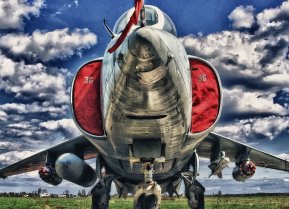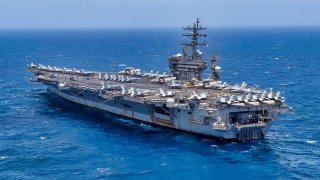The Navy's USS Dwight D. Eisenhower Aircraft Carrier Is a Floating Air Base
The USS Dwight D. Eisenhower “Ike” is the second of the ten Nimitz-class aircraft carriers in service with the Navy today. She is one powerful warship.
USS Dwight D. Eisenhower aircraft carrier: The U.S. Navy’s aircraft carrier USS Dwight D. Eisenhower(CVN-69) began operating in the Gulf of Oman last week alongside its escorts. Earlier in November. The warship was deployed to the Red Sea as part of the Pentagon’s efforts to deter hostile non-state and state actors from expanding the Israeli-Hamas war.
When the Gaza-based terror group waged its surprise massacre against the Jewish state on October 7, American and Israeli officials grew concerned that adversarial groups could enter the conflict.
The Iranian-backed Hezbollah in Lebanon and Houthis in Yemen have particularly shown a willingness to exploit the ongoing crisis in the region.
To deter these militias, the U.S. deployed two carrier strike groups to the Eastern Mediterranean. Defense Secretary Lloyd Austin ordered Eisenhower to move to the Central Command area of responsibility in light of increasing rocket barrages targeting U.S. personnel in Iraq and Syria.
More than 50 attacks targeting American military installations in both Syria and Iraq have been documented since Hamas’ massacre. The presence of the Navy’s carriers and strike groups in the region is critical at the moment since they may be a leading reason why these Iranian-aligned groups have not officially entered the ongoing war.
Nimitz-class carriers are valuable sea-based assets
The USS Dwight D. Eisenhower “Ike” is the second of the ten Nimitz-class carriers in service with the Navy today.
Named to honor the 34th president of the U.S. and General of the Army, the ship has remained in service for more than four decades.
In the 1970s, the Nimitz-class was developed to supplement its Kitty Hawk, Forrestal, and Enterprise class predecessors.
While these earlier ships were advanced for their era, the Nimitz-class brought increased fuel output and greater reactor quality to the service. Nimitz-class carriers are nuclear-powered, giving them a massive advantage over foreign counterparts.
This fuel source enables these ships to remain at sea for months at a time without needing refueling. Additionally, the nuclear power source generates power for the boat’s propulsion and electricity.

Measuring more than 1,000 feet long, the Nimitz-class carriers are well equipped to function as “floating airports” for America’s top airframes. The massive vessel displaces around 97,000 tons and is operated by roughly 5,000 sailors and Marines, including the airwing.
Each Nimitz-class carrier can typically fit an air wing comprised of two dozen F/A-18C Hornets, two dozen Super Hornets, several E/A-Growler electronic warfare jets, 4 E-2D Hawkeye airborne early warning and control aircraft, 6 Seahawk helicopters, and 2 C-2 Greyhound transport aircraft.
While the 1,000 foot length may seem long, a 60,000 pound Hornet fighter jet requires a longer runway. An additional steam catapult it fitted on the Nimitz-class carriers to circumvent this need for a longer runway.
As detailed by Popular Mechanics, “Steam is diverted from the ship’s boilers—steam boilers powered by the ship’s nuclear reactors—and piped up to just under the flight deck, where it is held and pressurized in special tanks. In the meantime, the front landing gear of a carrier aircraft is loaded onto a small, plate-sized shuttle. When the aircraft is ready for launch, the steam is suddenly released and, in a burst of power, accelerates the shuttle—and attached aircraft—down the flight deck to takeoff speeds.”

Armament-wise, the Nimitz-class aircraft carriers can pack a punch. To guard against anti-ship missiles and hostile aircraft, these ships are equipped with three and four NATO RIM-7 Sea Sparrow missile launchers and several 20mm Phalanx CIWS missile defense cannons.
These ships are also fitted with an AN/SLQ-32V system, which helps detect and interfere with enemy radar signals.
The Nimitz-class ships are also not without anti-submarine capabilities, including SSTDS torpedo defense systems and AN/SLQ-25 Nixie torpedo countermeasures.
USS Dwight D. Eisenhower Is a Powerhouse
Congress authorized CVN-69 in 1970, which it later commissioned seven years later. Following more than a year of fleet training, Ike was deployed to the Mediterranean. The mighty shift underwent a major overhaul to be fitted with newer technology in the mid-1980s and was later released back into the waters by 1987.
Over its lengthy service history, the USS Dwight D. Eisenhower has been deployed to a litany of combat operations. The ship’s first deployment was dubbed Operation Eagle Claw during the 1980 Iran hostage crisis.
One of the carrier’s most notable deployments took place during Iraq’s invasion of Kuwait in 1990. CVN-69 made history when she became the second nuclear-powered carrier ever to transit the Suez Canal.
The U.S. Navy’s aircraft carriers are considered by many to be the greatest deterrence assets available. These mighty and heavily armed ships can provide critical support for both offensive and defensive operations across the globe.
While the presence of the USS Dwight D. Eisenhower alone may not prevent Hezbollah and other adversarial groups from perpetuating the ongoing crisis in the Middle East, this ship is a reminder that America’s military power is not limited by geography.
About the Author
Maya Carlin is an analyst with the Center for Security Policy and a former Anna Sobol Levy Fellow at IDC Herzliya in Israel. She has by-lines in many publications, including The National Interest, Jerusalem Post, and Times of Israel. You can follow her on Twitter: @MayaCarlin.
All images are Creative Commons.


